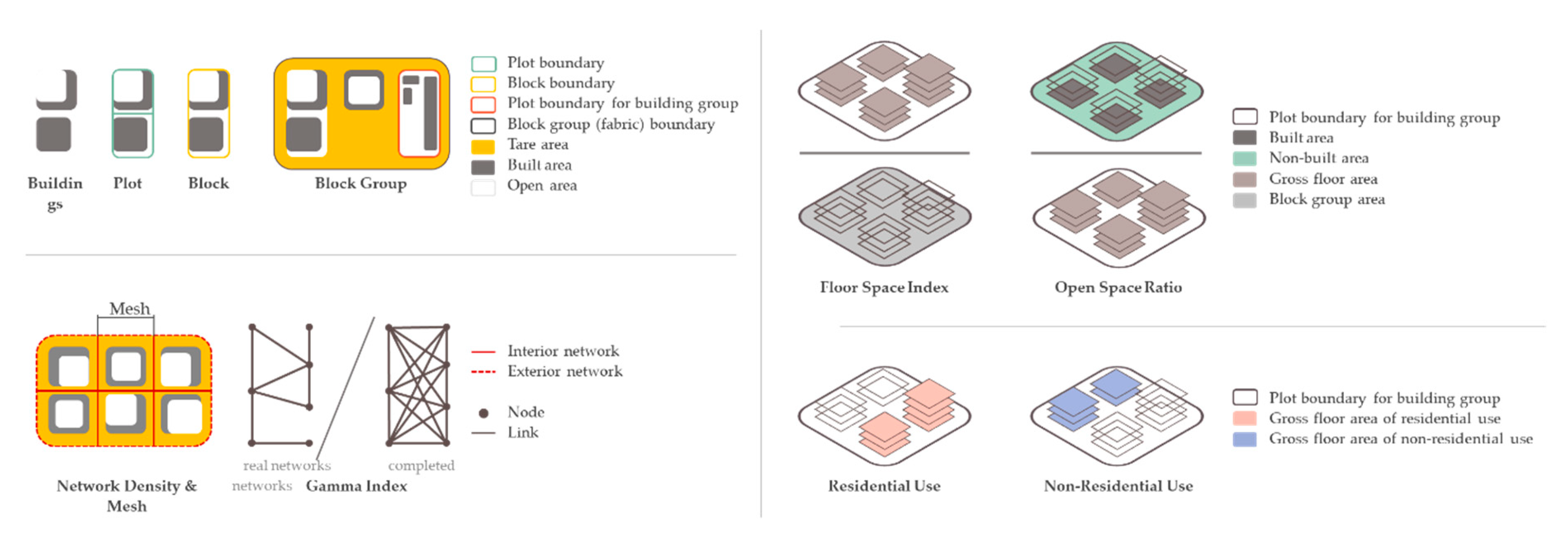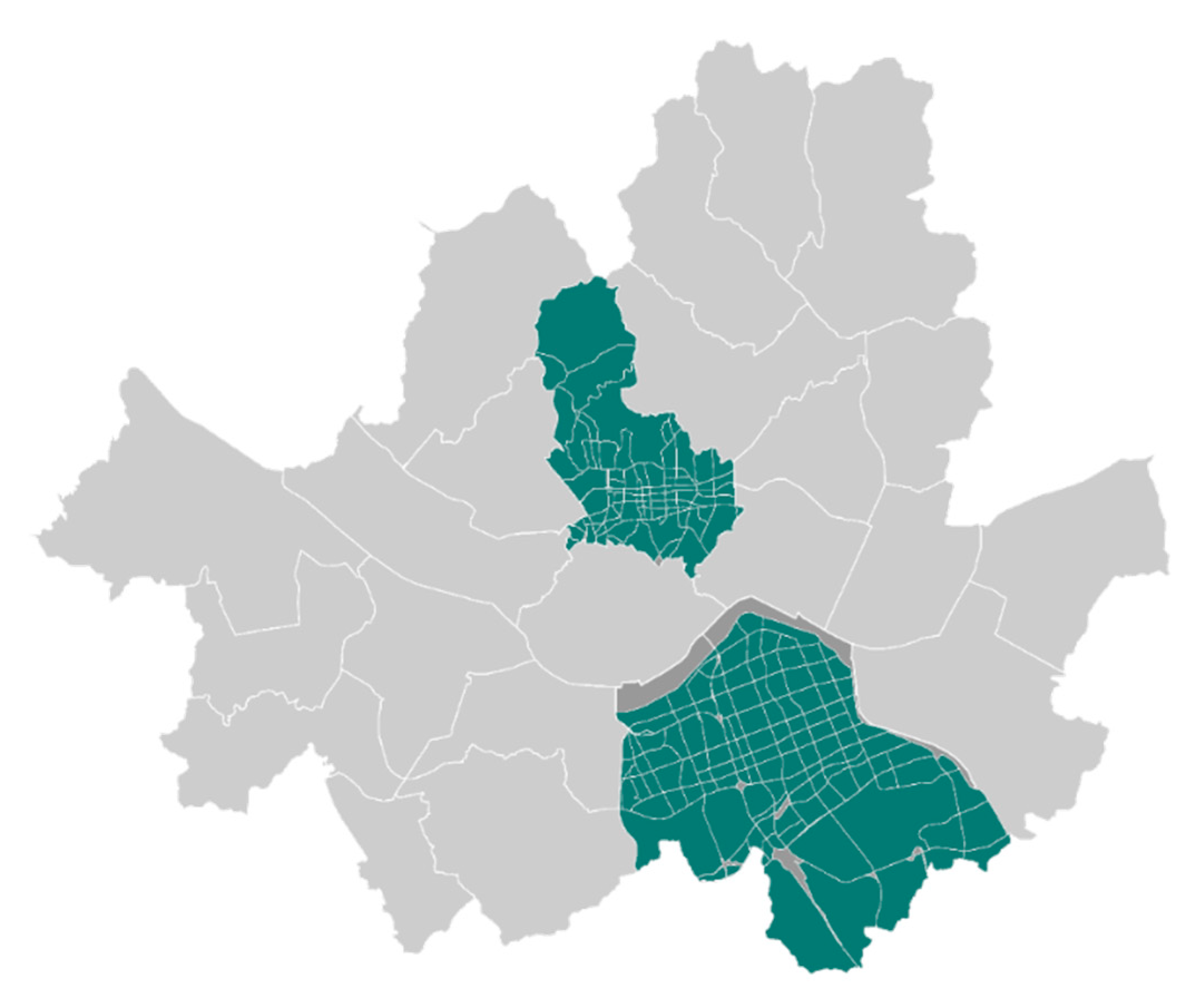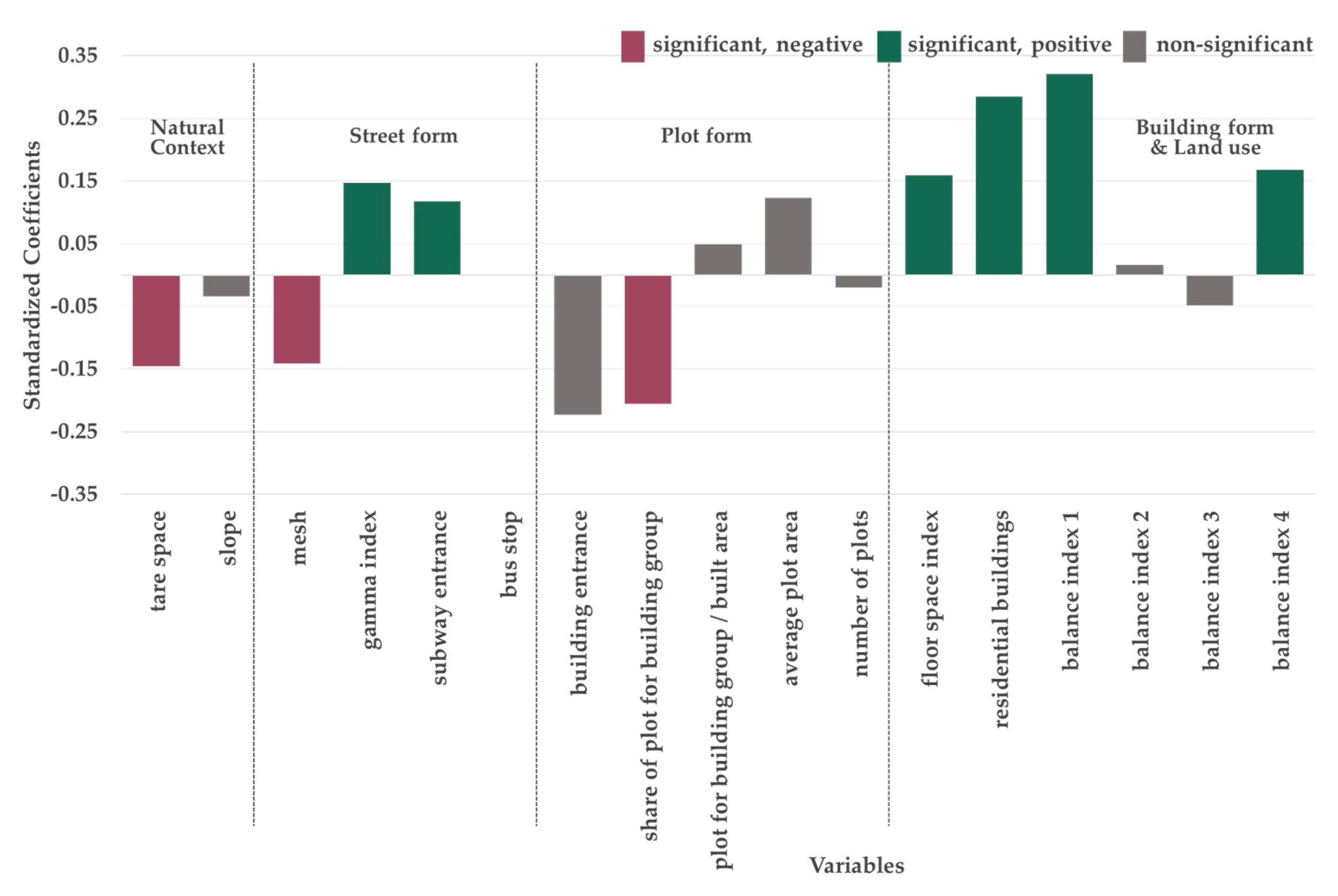Urban Vitality, Urban Form, and Land Use: Their Relations within a Geographical Boundary for Walkers
Abstract
1. Introduction
2. Study Site and Data Sources
3. Methodology
3.1. Geographic Scale to Capture Urban Form and Land Use Factors
- Expressways and arterials are the roadway functional classifications that mainly serve for the mobility of vehicles, not the actual activities of people.
- Massive single-use roadways play the role of borders in cities [1].
- The roadways (including arterials) where many vehicles pass at high speed decrease the frequency of people crossings [35].
- Livable and safe communities can be provided by narrow streets, not wide arterials [36].
- Public transit (subway and bus) is taken as one of the major transportation modes. Their routes pass mostly on arterials. In Seoul, subways account for 39.9% of transport, buses 25.1%, vehicles 24.4%, taxis 6.5%, and all others 4.1% [32].
3.2. Measuring Urban Form and Land Use Variables
3.3. Specification of Spatial Regression
4. Interpretation of Results
5. Conclusions and Discussion
Funding
Conflicts of Interest
Appendix A
| Variables | Measurement |
|---|---|
| Natural Context | |
| tare area | tare area/BGA |
| slope | average elevation of land |
| Network Form | |
| street network density | |
| mesh | 2/street network density |
| gamma index | number of links/3(number of nodes—2) |
| subway station entrance density | number of subway station entrances/BGA |
| bus stop density | number of bus stops/BGA |
| Plot Form | |
| building entrance density | number of building entrances/BGA |
| share of plot for building group | areas of plot area for building groups/areas of all plots |
| plot for building group / built area | areas of plots for building groups/built areas of all buildings |
| average plot area | sum of all areas of plots/number of plots |
| number of plots per km2 | number of plots BGA |
| Building Form and Land Use | |
| floor area ratio | gross floor area (GFA)/BGA |
| open space ratio | (1—built areas)/floor area ratio |
| residential buildings | GFA of residential buildings |
| balance index 1 | |
| balance index 2 | |
| balance index 3 | |
| balance index 4 | |
| Control Variables | |
| area of block group | block group area (BGA) |
| type of district | dummy variable |

References
- Jacobs, J. The Death and Life of Great American Cities; Vintage Books: New York, NY, USA, 1961. [Google Scholar]
- Gehl, J. Life between Buildings: Using Public Space; Island Press: Washington, DC, USA, 2011. [Google Scholar]
- Lynch, K. Good City Form; MIT Press: Cambridge, MA, USA, 1984. [Google Scholar]
- Montgomery, J. Editorial urban vitality and the culture of cities. Plan. Pract. Res. 1995, 10, 101–110. [Google Scholar] [CrossRef]
- Montgomery, J. Making a city: Urbanity, vitality and urban design. J. Urban Des. 1998, 3, 93–116. [Google Scholar] [CrossRef]
- Cervero, R.; Sarmiento, O.L.; Jacoby, E.; Gomez, L.F.; Neiman, A. Influences of built environments on walking and cycling: Lessons from Bogotá. Int. J. Sustain. Transp. 2009, 3, 203–226. [Google Scholar] [CrossRef]
- Kang, C.-D. Measuring the effects of street network configurations on walking in Seoul, Korea. Cities 2017, 71, 30–40. [Google Scholar] [CrossRef]
- Kim, S.; Park, S.; Jang, K. Spatially-varying effects of built environment determinants on walking. Transp. Res. Part A Policy Pract. 2019, 123, 188–199. [Google Scholar] [CrossRef]
- Kim, S.; Park, S.; Lee, J.S. Meso-or micro-scale? Environmental factors influencing pedestrian satisfaction. Transp. Res. Part D Transp. Environ. 2014, 30, 10–20. [Google Scholar] [CrossRef]
- Park, S.; Deakin, E.; Jang, K. Can Good Walkability Expand the Size of Transit-Oriented Developments? Transp. Res. Rec. 2015, 2519, 157–164. [Google Scholar] [CrossRef]
- Saelens, B.E.; Handy, S.L. Built environment correlates of walking: A review. Med. Sci. Sports Exerc. 2008, 40 (Suppl. 7), S550. [Google Scholar] [CrossRef] [PubMed]
- Sung, H.; Lee, S. Residential built environment and walking activity: Empirical evidence of Jane Jacobs’ urban vitality. Transp. Res. Part D Transp. Environ. 2015, 41, 318–329. [Google Scholar] [CrossRef]
- Sung, H.; Lee, S.; Cheon, S. Operationalizing Jane Jacobs’s urban design theory: Empirical verification from the great city of Seoul, Korea. J. Plan. Educ. Res. 2015, 35, 117–130. [Google Scholar] [CrossRef]
- Sung, H.; Lee, S.; Jung, S. Identifying the relationship between the objectively measured built environment and walking activity in the high-density and transit-oriented city, Seoul, Korea. Environ. Plan. B Plan. Des. 2014, 41, 637–660. [Google Scholar] [CrossRef]
- Sung, H.-G.; Go, D.-H.; Choi, C.G. Evidence of Jacobs’s street life in the great Seoul city: Identifying the association of physical environment with walking activity on streets. Cities 2013, 35, 164–173. [Google Scholar] [CrossRef]
- Ratti, C.; Frenchman, D.; Pulselli, R.M.; Williams, S. Mobile landscapes: Using location data from cell phones for urban analysis. Environ. Plan. B Plan. Des. 2006, 33, 727–748. [Google Scholar] [CrossRef]
- De Nadai, M.; Staiano, J.; Larcher, R.; Sebe, N.; Quercia, D.; Lepri, B. The death and life of great Italian cities: A mobile phone data perspective. In Proceedings of the 25th international conference on world wide web, Montreal, QC, Canada, 11–15 April 2016; pp. 413–423. [Google Scholar]
- Delclòs-Alió, X.; Gutiérrez, A.; Miralles-Guasch, C. The urban vitality conditions of Jane Jacobs in Barcelona: Residential and smartphone-based tracking measurements of the built environment in a Mediterranean metropolis. Cities 2019, 86, 220–228. [Google Scholar] [CrossRef]
- Jacobs-Crisioni, C.; Rietveld, P.; Koomen, E.; Tranos, E. Evaluating the impact of land-use density and mix on spatiotemporal urban activity patterns: An exploratory study using mobile phone data. Environ. Plan. A 2014, 46, 2769–2785. [Google Scholar] [CrossRef]
- Jin, X.; Long, Y.; Sun, W.; Lu, Y.; Yang, X.; Tang, J. Evaluating cities’ vitality and identifying ghost cities in China with emerging geographical data. Cities 2017, 63, 98–109. [Google Scholar] [CrossRef]
- Wu, W.; Niu, X. Influence of Built Environment on Urban Vitality: Case Study of Shanghai Using Mobile Phone Location Data. J. Urban Plan. Dev. 2019, 145, 04019007. [Google Scholar] [CrossRef]
- Ye, Y.; Li, D.; Liu, X. How block density and typology affect urban vitality: An exploratory analysis in Shenzhen, China. Urban Geogr. 2018, 39, 631–652. [Google Scholar] [CrossRef]
- Fotheringham, A.S.; Wong, D.W. The modifiable areal unit problem in multivariate statistical analysis. Environ. Plan. A 1991, 23, 1025–1044. [Google Scholar] [CrossRef]
- Jelinski, D.E.; Wu, J. The modifiable areal unit problem and implications for landscape ecology. Landsc. Ecol. 1996, 11, 129–140. [Google Scholar] [CrossRef]
- Clark, A.; Scott, D. Understanding the impact of the modifiable areal unit problem on the relationship between active travel and the built environment. Urban Stud. 2014, 51, 284–299. [Google Scholar] [CrossRef]
- Houston, D. Implications of the modifiable areal unit problem for assessing built environment correlates of moderate and vigorous physical activity. Appl. Geogr. 2014, 50, 40–47. [Google Scholar] [CrossRef]
- Yang, L.; Hu, L.; Wang, Z. The built environment and trip chaining behaviour revisited: The joint effects of the modifiable areal unit problem and tour purpose. Urban Stud. 2019, 56, 795–817. [Google Scholar] [CrossRef]
- Zhang, M.; Kukadia, N. Metrics of urban form and the modifiable areal unit problem. Transp. Res. Rec. 2005, 1902, 71–79. [Google Scholar] [CrossRef]
- Cervero, R.; Kockelman, K. Travel demand and the 3Ds: Density, diversity, and design. Transp. Res. Part D Transp. Environ. 1997, 2, 199–219. [Google Scholar] [CrossRef]
- Oliveira, V. Urban Morphology: An Introduction to the Study of the Physical Form of Cities; Springer: Berlin/Heidelberg, Germany, 2016. [Google Scholar]
- Rodrigue, J.-P.; Comtois, C.; Slack, B. The Geography of Transport Systems; Routledge: England, UK, 2016. [Google Scholar]
- Seoul Open Data Plaza. Available online: https://data.seoul.go.kr (accessed on 20 November 2020).
- Road Name Address. Available online: https://www.juso.go.kr (accessed on 20 November 2020).
- Korea National Spatial Data Infrastructure Portal. Available online: http://www.nsdi.go.kr (accessed on 20 November 2020).
- Donald, A.; Gerson, M.S.; Lintell, M. Livable Streets; University of California Press: Berkeley, CA, USA, 1981. [Google Scholar]
- Rosales, J. Road Diet Handbook: Setting Trends for Livable Streets; Parsons Brinckerhoff: New York, NY, USA, 2006. [Google Scholar]
- Berghauser-Pont, M.; Haupt, P. Spacematrix: Space, Density and Urban Form; NAi Publishers: Rotterdam, The Netherlands, 2010. [Google Scholar]
- Hillier, B. Spatial sustainability in cities: Organic patterns and sustainable forms. In Proceedings of the 7th International Space Syntax Symposium, Stockholm, Sweden, 8–11 June 2009. [Google Scholar]
- Cervero, R.; Duncan, M. Walking, bicycling, and urban landscapes: Evidence from the San Francisco Bay Area. Am. J. Public Health 2003, 93, 1478–1483. [Google Scholar] [CrossRef] [PubMed]
- Kelejian, H.H.; Prucha, I.R. On the asymptotic distribution of the Moran I test statistic with applications. J. Econ. 2001, 104, 219–257. [Google Scholar] [CrossRef]
- Anselin, L. Spatial Econometrics: A Companion to Theoretical Econometrics; Blackwell Publishing Ltd.: Hoboken, NJ, USA, 2001. [Google Scholar]
- Anselin, L. Spatial Econometrics: Methods and Models; Springer Science & Business Media: Berlin/Heidelberg, Germany, 2013; Volume 4. [Google Scholar]
- Vega, S.H.; Elhorst, J.P. On spatial econometric models, spillover effects, and W. In Proceedings of the 53rd ERSA Congress, Palermo, Italy, 27–31 August 2013. [Google Scholar]
- Anselin, L. Lagrange multiplier test diagnostics for spatial dependence and spatial heterogeneity. Geogr. Anal. 1988, 20, 1–17. [Google Scholar] [CrossRef]
- Bivand, R.; Bernat, A.; Carvalho, M.; Chun, Y.; Dormann, C.; Dray, S.; Halbersma, R.; Lewin-Koh, N.; Ma, J.; Millo, G. The spdep package. Compr. R Arch. Netw. Version 2005, 5–83. [Google Scholar]
- Bivand, R.; Pebesma, J.; Gómez-Rubio, V.; Pebesma, E. Applied Spatial Data Analysis with R; Springer: New York, NY, USA, 2008. [Google Scholar]
- Ewing, R.; Bartholomew, K. Pedestrian & Transit-Oriented Design; Urban Land Institute: Washington, DC, USA, 2013. [Google Scholar]
- Joo, S.-M.; Kim, J.-Y. A Study on Street Vitality of Two Different Types of Superblocks—With a case of Yeoksam 2-dong, Seoul. J. Archit. Inst. Korea Plan. Des. 2019, 35, 71–82. [Google Scholar]
- Chourabi, H.; Nam, T.; Walker, S.; Gil-Garcia, J.R.; Mellouli, S.; Nahon, K.; Pardo, T.A.; Scholl, H.J. Understanding smart cities: An integrative framework. In Proceedings of the 2012 45th Hawaii international conference on system sciences, Maui, HI, USA, 4–7 January 2012; pp. 2289–2297. [Google Scholar]
- Neirotti, P.; De Marco, A.; Cagliano, A.C.; Mangano, G.; Scorrano, F. Current trends in Smart City initiatives: Some stylised facts. Cities 2014, 38, 25–36. [Google Scholar] [CrossRef]



| Variables | Description | Unit | Mean | Std. Dev |
|---|---|---|---|---|
| Dependent Variable | ||||
| service population | number of local population and foreigners | thousand people | 161.800 | 124.556 |
| Explanatory Variable | ||||
| Natural Context | ||||
| tare area | unused or unavailable areas for people | km2/km2 | 0.306 | 0.158 |
| slope | average elevation of land | degree | 3.549 | 4.304 |
| Network Form | ||||
| street network density | density of street networks | km/km2 | 0.020 | 0.012 |
| mesh | average length between streets in a square grid | km/km2 | 141.547 | 124.130 |
| gamma index | connectivity of street networks | 0.294 | 0.129 | |
| subway station entrance density | station entrances per 1 km2 | number/km2 | 7.591 | 11.456 |
| bus stop density | bus stops per 1 km2 | number/km2 | 32.170 | 20.588 |
| Plot form | ||||
| building entrance density | building entrances per 1 km2 | number/km2 | 1264.031 | 1255.164 |
| share of plot for building group | share of plot area for building group against all plots | km2/km2 | 0.057 | 0.144 |
| plot for building group / built area | ratio of plot area for building groups against built area of all buildings | km2/km2 | 2.427 | 2.944 |
| average plot area | average area of plots | km2 | 0.002 | 0.004 |
| number of plots per km2 | number of plots per 1 km2 | number/km2 | 2673.673 | 2859.738 |
| Building Form and Land Use | ||||
| floor area ratio | building intensity | km2/km2 | 1.590 | 1.128 |
| open space ratio | spaciousness | km2/km2 | 2.201 | 11.518 |
| residential buildings | gross floor area of residential buildings | number | 0.456 | 0.288 |
| balance index 1 | balance index between gross floor areas of neighborhood commercial and residential buildings | index | 0.461 | 0.305 |
| balance index 2 | balance index between gross floor areas of non-daily commercial and residential buildings | index | 0.173 | 0.240 |
| balance index 3 | balance index between gross floor areas of office and residential buildings | index | 0.111 | 0.171 |
| balance index 4 | balance index between gross floor areas of education and welfare and residential buildings | index | 0.163 | 0.239 |
| Control Variables | ||||
| area of block group | block group area | km2 | 0.523 | 0.940 |
| type of district | north districts = 1 south districts = 0 | dummy variable | 0.392 | 0.489 |
| Model | Statistics | p-Value | Acceptance |
|---|---|---|---|
| Spatial error model | 4.792 | 0.029 | Reject |
| Spatial autoregressive model | 10.311 | 0.001 | Reject |
| Robust Spatial error model | 0.221 | 0.639 | Accept |
| Robust Spatial autoregressive model | 5.739 | 0.017 | Reject |
| Moran’s I of Residuals | Log-Likelihood | Adj. R2 | AICc | ||
|---|---|---|---|---|---|
| OLS | 0.055 (0.000) | 0.363 | 2683.7 | ||
| Spatialautoregressive model | 0.012 (0.247) | −1316.189 | 0.443 | 2676.4 | |
| Variables | Coef. | Std. Coef. | Std. error | z-value | p > |z| |
| Natural Context | |||||
| Tare ** | −129.930 | −0.146 | 61.188 | −2.123 | 0.034 |
| slope | −1.094 | −0.034 | 2.794 | −0.392 | 0.695 |
| Network form | |||||
| Mesh * | −0.159 | −0.141 | 0.092 | −1.721 | 0.085 |
| gamma index ** | 159.510 | 0.147 | 70.838 | 2.252 | 0.024 |
| subway entrance density * | 1.428 | 0.117 | 0.796 | 1.794 | 0.073 |
| bus stop density | −0.016 | −0.002 | 0.395 | −0.039 | 0.969 |
| Plot form | |||||
| building entrance density | −0.025 | −0.223 | 0.016 | −1.558 | 0.119 |
| share of plot for building group ** | −200.020 | −0.206 | 75.329 | −2.655 | 0.00 |
| plot for building group/built area | 2.349 | 0.049 | 3.286 | 0.715 | 0.475 |
| average plot area | 4268.100 | 0.123 | 3048.600 | 1.400 | 0.162 |
| number of plots per km2 | −0.001 | −0.020 | 0.007 | −0.137 | 0.891 |
| Building form and land use | |||||
| floor area ratio ** | 19.739 | 0.159 | 8.371 | 2.358 | 0.018 |
| residential buildings *** | 55.269 | 0.284 | 12.187 | 4.535 | 0.000 |
| balance index 1 *** | 149.560 | 0.320 | 33.530 | 4.460 | 0.000 |
| balance index 2 | 7.903 | 0.016 | 35.691 | 0.221 | 0.825 |
| balance index 3 | −29.137 | −0.049 | 29.625 | −0.984 | 0.325 |
| balance index 4 ** | 74.420 | 0.168 | 30.377 | 2.450 | 0.014 |
| Control variables | |||||
| area of unit *** | 41.126 | 0.276 | 12.790 | 3.216 | 0.001 |
| type of district | 21.656 | 0.076 | 23.715 | 0.913 | 0.361 |
| intercept | −5.518 | 49.227 | −0.112 | 0.911 | |
| *** | 0.392 | 0.109 | 3.592 | 0.000 | |
Publisher’s Note: MDPI stays neutral with regard to jurisdictional claims in published maps and institutional affiliations. |
© 2020 by the author. Licensee MDPI, Basel, Switzerland. This article is an open access article distributed under the terms and conditions of the Creative Commons Attribution (CC BY) license (http://creativecommons.org/licenses/by/4.0/).
Share and Cite
Kim, S. Urban Vitality, Urban Form, and Land Use: Their Relations within a Geographical Boundary for Walkers. Sustainability 2020, 12, 10633. https://doi.org/10.3390/su122410633
Kim S. Urban Vitality, Urban Form, and Land Use: Their Relations within a Geographical Boundary for Walkers. Sustainability. 2020; 12(24):10633. https://doi.org/10.3390/su122410633
Chicago/Turabian StyleKim, Suji. 2020. "Urban Vitality, Urban Form, and Land Use: Their Relations within a Geographical Boundary for Walkers" Sustainability 12, no. 24: 10633. https://doi.org/10.3390/su122410633
APA StyleKim, S. (2020). Urban Vitality, Urban Form, and Land Use: Their Relations within a Geographical Boundary for Walkers. Sustainability, 12(24), 10633. https://doi.org/10.3390/su122410633





